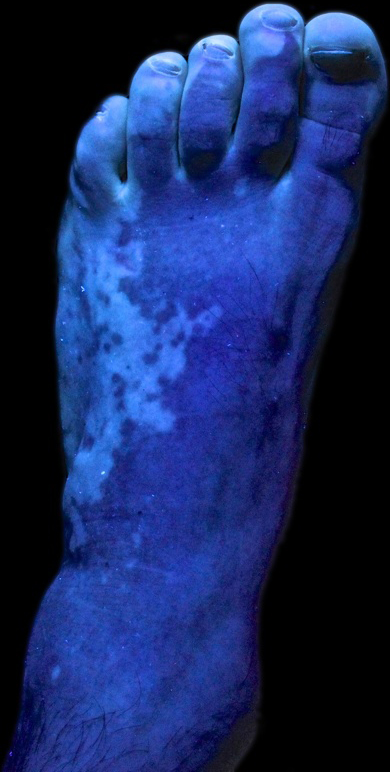Vitiligo
Vitiligo (/ˌvɪtɪˈlaɪɡoʊ/) is a chronic autoimmune disorder that leads to the loss of skin pigment, resulting in white patches on the skin. The exact cause of vitiligo is unknown, but it is suspected to involve immune system changes, genetic factors, stress, and sun exposure. The condition can affect any skin type and appear anywhere on the body.

Signs and Symptoms
The primary sign of vitiligo is the presence of pale, patchy areas of depigmented skin, which usually appear on the extremities. Some individuals may experience itching before a new patch forms. These patches start small but often grow and change shape. They are most noticeable on the face, hands, wrists, and areas around body orifices such as the mouth, eyes, nostrils, genitalia, and umbilicus.
Some patches may have increased pigment around the edges. The psychological impact of vitiligo can lead to depression and other mood disorders due to stigmatisation.



Causes
The pathogenesis of vitiligo is believed to involve a combination of genetic susceptibility and environmental factors, leading to changes in the immune system. The condition is thought to result from the immune system attacking and destroying melanocytes, the cells responsible for producing melanin, the pigment that gives skin its colour. Certain genes, such as the TYR gene encoding tyrosinase, an enzyme very important for melanin biosynthesis, have been implicated.
Vitiligo is also associated with other autoimmune and inflammatory diseases, including Hashimoto's thyroiditis, rheumatoid arthritis, type 1 diabetes, and systemic lupus erythematosus.
Diagnosis
Diagnosis of vitiligo is primarily clinical, based on the appearance of the characteristic white patches. An ultraviolet light, or Wood's lamp, can be used to highlight areas of depigmentation. This tool is particularly useful in early stages or in individuals with fair skin where the contrast might be less obvious.


Classification
Vitiligo is classified into segmental and non-segmental types. Non-segmental vitiligo (NSV) is the most common form, usually showing symmetry in patch distribution and potentially covering large areas of the body. Segmental vitiligo (SV) is less common and tends to be unilateral, affecting areas of skin associated with specific spinal cord roots.
Non-Segmental Vitiligo
NSV can appear at any age and includes generalised, universal, focal, acrofacial, and mucosal subtypes based on the distribution and extent of depigmentation.
Segmental Vitiligo
SV often appears in younger individuals and is more stable. It affects specific skin areas along dermatomal lines and has fewer associations with autoimmune diseases compared to NSV.
Treatment
While there is no cure for vitiligo, several treatments can help manage the condition. Topical corticosteroids and calcineurin inhibitors are first-line treatments. Phototherapy, using UVB light, is a second-line option, though it carries a risk of skin cancer with prolonged use.
Immune Mediators
Topical immune suppressing medications, including glucocorticoids and calcineurin inhibitors, are commonly used. In 2022, ruxolitinib cream was approved in the United States for vitiligo treatment.
Phototherapy
Phototherapy involves exposing the affected skin to UVB light, which can be done at home or in a clinical setting. Narrowband UVB is preferred over broadband UVB and PUVA (psoralen and UVA) due to fewer side effects.
Skin Camouflage and Depigmenting
For mild cases, cosmetic camouflage can conceal patches. In extensive vitiligo, depigmentation of unaffected skin may be considered to achieve uniform skin colour using topical agents like monobenzone.
Research
Research continues into treatments, including afamelanotide and tofacitinib, a medication for rheumatoid arthritis. Melanocyte transplantation and Janus kinase inhibitors like ruxolitinib show promise in clinical trials for repigmenting vitiligo-affected skin.

Self-assessment MCQs (single best answer)
What is the primary sign of vitiligo?
Which of the following genes has been implicated in the pathogenesis of vitiligo?
What tool is particularly useful for highlighting areas of depigmentation in vitiligo?
Which form of vitiligo is most common?
In 2022, which cream was approved in the United States for the treatment of vitiligo?
Which type of phototherapy is preferred for vitiligo treatment due to fewer side effects?
Which autoimmune diseases are commonly associated with vitiligo?
What is the main function of melanocytes that are destroyed in vitiligo?
Which topical agents are used for depigmentation of unaffected skin in extensive vitiligo?
What is the psychological impact of vitiligo that can affect individuals?
Dentaljuce
Dentaljuce provides Enhanced Continuing Professional Development (CPD) with GDC-approved Certificates for dental professionals worldwide.
Founded in 2009 by the award-winning Masters team from the School of Dentistry at the University of Birmingham, Dentaljuce has established itself as the leading platform for online CPD.
With over 100 high-quality online courses available for a single annual membership fee, Dentaljuce offers comprehensive e-learning designed for busy dental professionals.
The courses cover a complete range of topics, from clinical skills to patient communication, and are suitable for dentists, nurses, hygienists, therapists, students, and practice managers.
Dentaljuce features Dr. Aiden, a dentally trained AI-powered personal tutor available 24/7 to assist with queries and provide guidance through complex topics, enhancing the learning experience.
Check out our range of courses, or sign up now!


